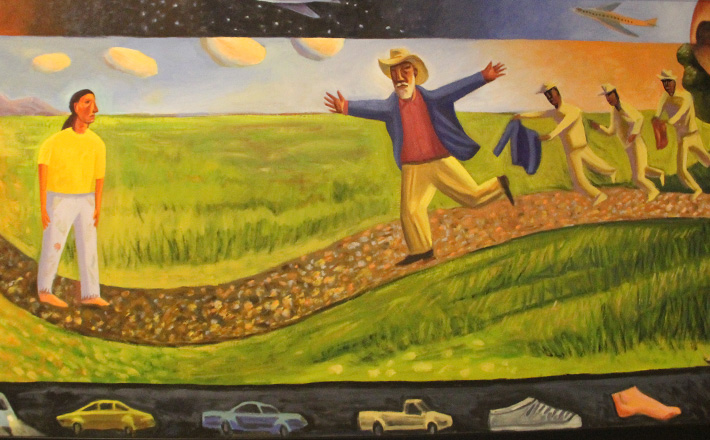Commentary on Psalm 30
Psalm 30 is an Individual Psalm of Thanksgiving.
This genre presupposes a past experience where the poet was in trouble, prayed about it, and received an answer in a dramatic way from God. Only a small number of such Psalms are in the Bible (18, 34, 40, 52, 66, 116, and 130). Considering that only a third of the Psalms are laments, we may be surprised at the small number of this kind of Psalm.
The occasion is very personal. Someone has had a near-death experience. Previously, this person felt very secure and confident, but the brush with death changed everything. Now, the whole purpose and center of life is praise.
When and by whom was it written? The superscription suggests it was David’s work, composed for use at the dedication of the Temple. This cannot be so, for David was already dead before Solomon began constructing it. Labeling the Psalm as “Of David” is better translated as “For David,” implying that it should be used by the reigning king. Some have thought that the word ‘Hanukkah,’ translated as ‘dedication,’ refers to the event celebrated even today by the Jewish community in December for eight days. However, that holiday began in 165 B.C.E. when the temple was rededicated after its desecration by Antiochus IV, the Syrian emperor. Based on the content of the Psalm, it appears far older than this event.
As a Psalm of Thanksgiving, we would expect Psalm 30 to be comprised of certain elements. It refers back to a time of distress (verses 2a, 7b), to a call for help (verses 5, 6, 7), and to God’s answer, a deliverance (verses 2b, 3, 11). God’s graciousness and power (verses 1, 5, 7a), and the actual thanksgiving (verses 1, 4, 12) are, of course, essential elements of such Psalms.
The structure of Psalm 30 shows a good deal of repetition. Samuel Terrien analyzed it so as to find the pattern a, a’, b, b’, etc.1 We will follow this arrangement in the comments which follow.
In Verse 1, we find the basis for the thanksgiving, echoed later in verse 11. The present situation of the Psalmist is contrasted with an earlier one. There is no longer any reason to fear. Foes did play a role in the past, as they did for a good number of Psalmists (cf. Psalm 31:18). Possibly, these foes thought the writer was previously getting what was deserved because of sinful conduct. But there is no confession of sin, only admission of an earlier attitude of self-confidence. In ancient Israel, one’s experience of grief or joy was not only expressed in facial expression or words, but also in clothing.
Verses 2 and 10 should also be parallel. They are remembrances of what was said to God in the time of trouble. They were desperate but hopeful cries, knowing that Yahweh is gracious (verse 10).
Verses 3 and 9 reflect an ancient world-view shared by Israel with its neighbors. The underworld (Sheol, the Pit) was part of the observed three-story universe. Those who died, while buried in the ground, were connected to a kind of half-life in this lower level of the earth. Worst of all, they were cut off from contact with God. Part of the Psalmist’s petition in verse 9 is an argument against the Psalmist’s death, since it will cut off God from the Psalmist’s praise, and reflect negatively on God’s faithfulness.
Verses 4 and 8 should, but do not, reflect the same idea. The earlier verse calls for others to join the Psalmist in praise for the healing that took place (verse 3). The latter verse is just another way of telling what the Psalmist’s petition was, which continues in verse 9.
Verses 5 and 7 again seem to express, in two different ways, the way the Psalmist experienced the life-threatening episode. It was not only physical suffering; it was also thought to be the result of God’s anger, a hiding of God’s face. But it was short-lived, somewhat like a bad night followed by a good morning and continuing on in life-long divine favor. Verse 7 says that the author thought that his mountain stood firm until the death-threat suddenly emerged. When all is going well, pride may indeed go before a fall.
Verse 6, if Terrien is right, is the focal point of the Psalm. Now, the writer sees things very differently than before the emergency. A great change of attitude has taken place. But this verse does not express what the new attitude really is. We have already heard it in verse 1, and it concludes in verse 12. The psalmist is now in a life-long mode of praise.
We have all met people near death and in depression and pain. At times, it may be our own experience too. It is part of human existence. Whether it will be felt as a divine visitation of disfavor or punishment is another matter. Some suffering we do bring on ourselves because God’s world does not make exceptions to the consequences of our actions. If and when reprieve comes, there may also be a changed attitude toward everything, especially toward God.
In pastoral counseling one may enter with the relieved sufferer in a far more intimate way than is possible from the pulpit. Should one announce that suffering and the shadow of death are divine punishment? Is death the consequence of sin or only the natural end of life necessary to make room for the next generation? It seems our bodies were meant to serve us for a limited life span. The next life will be different, and thus Jesus’ resurrection is the key event which changes us from lamenters to praisers. Surely not all sufferers escape death as the Psalmist did. Should or will they praise God anyway? In an age where medicine plays such a great role in healing, do people still see God’s involvement in the process?
1Samuel Terrien, The Psalms (Grand Rapids: William B. Eerdmans Publishing Company, 2003).


April 18, 2010